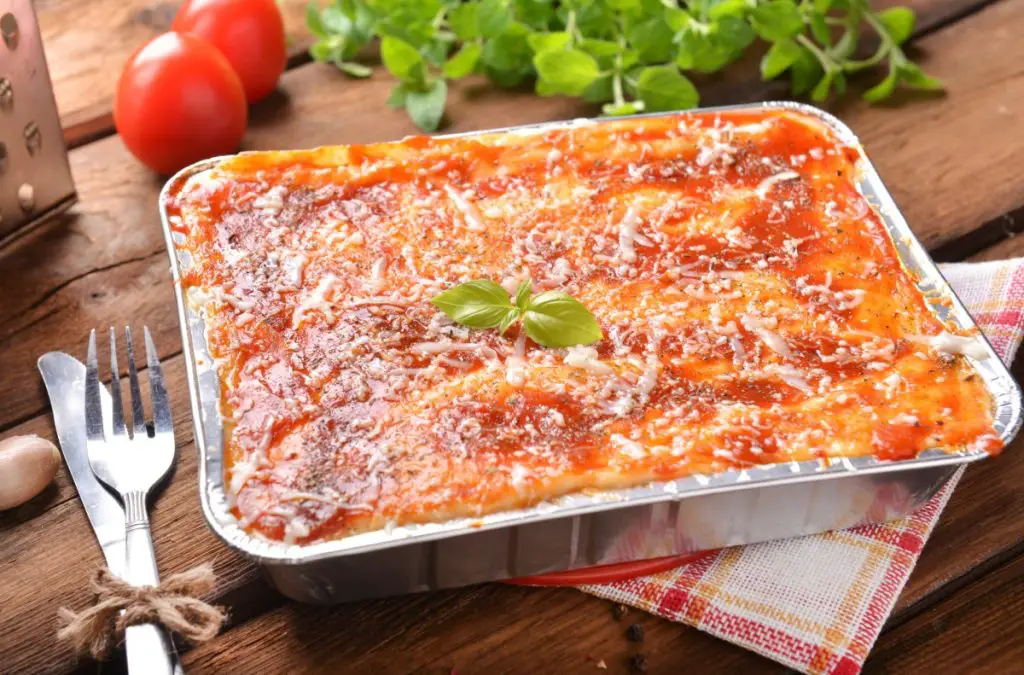Easy Guide to Freezing Lasagna (The Ideal Freezer Food)
Lasagna’s one of those dishes that most people can’t get enough of, and it’s hard to make just enough for one meal when you’re filling up a baking dish with such appetizing ingredients. Most people end up with lasagna leftovers, and sticking them in the freezer for later makes sense.
You can freeze lasagna after you cook it. The ingredients in lasagna won’t taste different if you freeze them, so your frozen leftovers will taste just like fresh-cooked lasagna once thawed and reheated. The quality of your lasagna, however, will suffer if you attempt to freeze it repeatedly.
In this article, I’ll tell you how to properly freeze lasagna. I’ll also explain why lasagna freezes so well, tell you how long it will last in the freezer, and show you how to thaw your lasagna so it will taste just as good as the first time.

How To Freeze Lasagna for Best Results
Freezing your leftover lasagna is a simple way to make it last longer and keep it available whenever you need a quick meal.
Before you attempt to store your lasagna in the freezer, it is best to allow it to cool to room temperature. That’s because putting still warm lasagna in the freezer or fridge will reduce its quality once frozen. If you put your hot lasagna in the freezer right away, it will lose its consistency, plus the glass pan may break from the rapid temperature change.
So, allow your lasagna to cool for up to 2 hours before storing it. Then, you can either leave it in the pan you made it in or transfer it to another container. Keeping your lasagna in the container you cooked it in is usually the best method, though, since it will preserve the layers and prevent your lasagna from becoming a mess.
The key to freezing lasagna successfully is to have it well-protected from the cold freezer air that will dry it out and cause freezer burn.
To do this, you’ll want to cover your lasagna with aluminum foil, a lid, or plastic wrap. You can also pull a freezer bag over the pan for the best air-tight seal. Be sure to “seal” the lasagna, eliminating air holes or gaps to prevent freezer burn.
Then stick your lasagna in the freezer. It’s as simple as that!
Why Lasagna Freezes So Well
Freezing your lasagna after you cook it is perfectly okay. Typically, after you cook food, it releases moisture, making it dried out and hard to eat once frozen and thawed. Since lasagna includes layers of moisture-packed ingredients and firm starch noodles, it’s one of the better foods to freeze after cooking.
Dense foods with vital starch and protein structures, such as lasagne noodles and other pasta, do very well in the freezer due to their resistance to being negatively affected by ice crystals. Starch is malleable and contains low moisture levels, and becomes al dente when cooked again. In addition, any liquids that do not emulsify do great when frozen.
That’s why lasagna won’t lose its flavor or texture, no matter how long you freeze it. It contains the starch layers for preventing sharp ice crystals, it has a ton of sauce, and it’s a very dense food. All three characteristics of lasagna cause it to do very well in the freezer. That is likely why it’s such a popular freezer food.
Still, constantly thawing and refreezing food allows too much moisture to escape, so it’s best to avoid freezing your lasagna for a third or fourth time if you don’t want to eat chewy leather. The whole purpose of freezing your lasagna is to preserve the taste and quality, which you will lose with multiple thawings.

How Long Does Lasagna Last in the Freezer?
Lasagna will last in the freezer indefinitely, like most moist foods. However, it may develop freezer burn after a while, so most people recommend sealing it in an airtight container and eating it within two years of freezing.
The USDA recommends freezing your lasagna to 0º F (-17.8º C) for food safety. Using such a low temperature will preserve the quality as much as possible. Since many foods and liquids don’t always freeze at 32º F (0º F), it’s better to have your freezer set to zero to keep food fresh. Lasagna is no exception.
Freezing your lasagna for a long time makes most people concerned about freezer burn. For anyone concerned about freezer burn, as long as your lasagna is in an airtight container or wrapped in a vacuum-sealed pack, it shouldn’t get overly dried out or freezer burnt.
Freezer burn can only occur when you expose your frozen foods to air, so as long as you keep your lasagna sealed up tight, you will have no problem with it.
Writing down a date on your lasagna before you freeze it can help maintain its quality. Just because your lasagna can last in the freezer indefinitely, there is a point where the quality of your lasagna will suffer. Having a date on the container will help ensure that you eat your lasagna while it’s still fresh.
Most foods, including lasagna, should be kept in the freezer for a maximum of two years if you want to maintain good quality. It is still edible if you decide to keep it longer – it just won’t taste quite as fresh as time goes by.
Despite what most people think, freezing your food – or, in this case, your lasagna – doesn’t reduce the number of nutrients and vitamin content. It won’t take away the color, either. So after you freeze your lasagna, it’s important to thaw it correctly to continue preserving those vitamins and nutrients.

How to Thaw & Reheat Frozen Lasagna
The best-proven ways of reheating your lasagna are using the methods you would use to cook it. In other words, use the oven!
By wrapping your lasagna in foil and baking it in the oven again, you’re locking in the moisture from the ice and heating it simultaneously. Wrapping it in foil ensures the inside remains as moist as it was the first time around.
If you’re not going to eat your lasagna immediately, but you know you’re not going to have the time to wait for it to defrost and reheat in the oven, thaw it overnight in the refrigerator. Raising the temperature slowly overnight allows the moisture to remain in between your lasagna layers instead of pooling to the bottom as a quick thaw does.
Quick thaws are thawing foods quickly instead of gradually. Typical quick thaws are out on the warm counter or in a sink with warm water. Avoid quick thaws with your lasagna and stick to the gradual, overnight thaws.
After you thaw the lasagna in the fridge, wrap it securely in foil like you would the first night you cooked it. If you notice that your family had previously eaten a significant portion of your lasagna, and now there is ample space in your pan, I learned a nifty trick.
Wrap the foil around your lasagna instead of your pan. Sectioning the food off keeps the moisture in your lasagna instead of seeping out and pooling in your pan.
Ideally, don’t refreeze it once you’ve frozen and thawed your lasagna for its second life. Doing so will take a toll and reduce its quality.
Conclusion
Since lasagna has starchy and moist layers, it’s one of the best foods to freeze after you’ve cooked it. It’ll last in a cold freezer indefinitely, but you should eat it within two years for the best taste, color, and texture. Be sure to thaw it slowly, and don’t re-freeze your leftovers.






